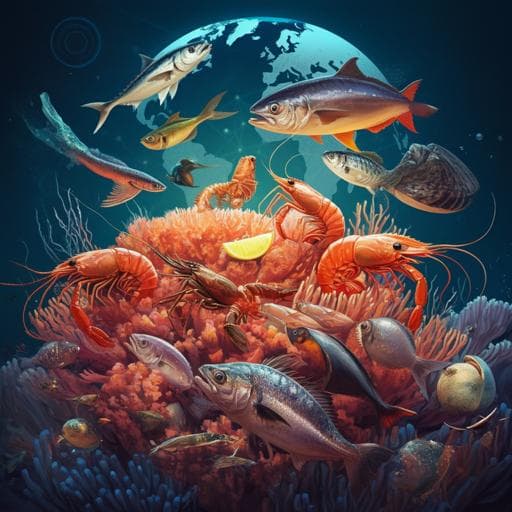
Food Science and Technology
Four ways blue foods can help achieve food system ambitions across nations
B. I. Crona, E. Wassénius, et al.
Discover how blue foods from our oceans can enhance nutrition, reduce environmental footprints, and support just economies under climate change, as unraveled by a team of expert researchers including Beatrice I. Crona and Emmy Wassénius. Dive into the exciting findings of the Blue Food Assessment and find out how different countries can benefit from promoting blue food consumption.
~3 min • Beginner • English
Introduction
The paper addresses how diverse aquatic “blue foods” can contribute to transforming national food systems toward improved nutrition, equity, and lower environmental impacts. Despite their importance, blue foods are often overlooked or simplified in food policy and dietary guidance. The authors highlight the substantial diversity of blue foods (thousands of wild and farmed species) and their varying roles in nutrition, health, livelihoods, culture, and environmental performance. Given the uneven distribution of benefits and resilience across countries and the social-ecological inequities that shape access, the study’s purpose is to integrate findings from the Blue Food Assessment and articulate context-specific policy objectives. These objectives aim to leverage blue foods to reduce nutrient deficiencies, lower non-communicable disease risks associated with red meat overconsumption, reduce dietary environmental footprints, and safeguard nutrition, livelihoods, and cultures under climate change. The work provides a framework for policymakers to identify relevant objectives for their national contexts and understand potential co-benefits and trade-offs.
Literature Review
The study synthesizes the Blue Food Assessment, which brought together over 100 scholars to evaluate blue foods across nutrition, environment, demand, vulnerability to stressors, climate risks, and justice/equity dimensions. Prior research has shown blue foods can be nutrient dense (notably vitamin B12 and EPA/DHA), often have lower environmental impacts than many terrestrial meats, support livelihoods for hundreds of millions, and are crucial to many cultures. Yet fisheries and aquaculture are frequently neglected in nutrition policy and food system agendas, and ocean policy often overlooks blue food contributions to human wellbeing. The literature also documents variability in environmental performance across species and production systems, the potential for improved management and technological innovations to reduce impacts, and structural inequities that concentrate wealth in industrial actors and marginalize small-scale fisheries and aquaculture (SSFA). The assessment and broader literature emphasize climate change as a systemic threat to aquatic food systems and the need for adaptation to protect nutrition, equity, and livelihoods.
Methodology
The authors translate blue food functions into four policy objectives and map their national relevance using publicly available, country-level data and expert-informed cutoff criteria. The four objectives are: (1) reduce blue-food-sensitive nutrient deficiencies (vitamin B12 and omega-3 EPA/DHA) via increased access/consumption; (2) reduce non-communicable disease risk, exemplified by cardiovascular disease associated with high red meat intake, by substituting toward low-impact blue foods; (3) reduce environmental footprints of diets by partially replacing ruminant meat with low-impact blue foods; and (4) safeguard contributions of blue foods to nutrition, just economies, livelihoods, and cultures under climate change by prioritizing climate resilience. For each objective, the team identified conditions of relevance and used proxy indicators, thresholds, and rules (detailed in Supplementary Tables; sensitivity analyses in Extended Data). For example, they used summary exposure values for inadequate vitamin B12 and omega-3 intake and measures of blue food availability (domestic production and/or trade) to identify countries where deficiency reduction is relevant. They mapped cardiovascular disease risk alongside red meat intake and blue food availability to gauge the potential for health improvements. For environmental footprint reduction, they considered ruminant meat intake and the availability of blue foods. For safeguarding under climate change, they combined current national dependence on nutrition, employment, and revenue from blue foods with climate hazard exposure to identify where adaptation is most urgent. Results are visualized at global scale (Fig. 1), with an interactive tool allowing users to adjust cutoff points and explore policy relevance (https://gedb.shinyapps.io/BFA_synthesis/).
Key Findings
- The four policy objectives provide a structured way to leverage blue foods for nutrition, health, environmental, and equity goals, accounting for national context.
- Nutrient deficiencies: 43 countries have >10% of the population at risk of inadequate vitamin B12 intake; 89 countries show high omega-3 deficiency risk, predominantly in Africa and South America. Many of these nations also have high blue food availability, indicating potential to alleviate deficiencies by improving access and consumption among nutritionally vulnerable groups.
- Health and red meat substitution: Countries exceeding sustainable/healthy red meat intake thresholds with high cardiovascular disease incidence are largely in the global North (with some small-island exceptions), and many already have blue food availability. Moderate consumption of low-impact seafood could reduce CVD burden.
- Environmental footprints: 124 countries have high ruminant meat intake contributing to elevated dietary GHG footprints. Many produce or import substantial blue foods (for example, Belgium, Chile, Norway, France, Denmark), suggesting potential to shift some production/imports to domestic consumption, albeit with trade-offs (e.g., reduced export revenue).
- Safeguarding under climate change: 103 countries currently rely significantly on blue foods for nutrition, livelihoods, or national revenue. Overlaying climate hazards identifies countries at high future risk where adaptation will be crucial to maintain benefits.
- Overlaps and co-benefits: Among the 89 countries where omega-3 policies are relevant, 75% also have environmental footprint reduction relevance. Of 22 countries with high CVD risk, 82% also align with environmental footprint reduction via shifting from ruminant meat to blue foods. 91% of countries with vitamin B12 deficiencies also show high omega-3 deficiency, reflecting general undernutrition and low blue food intake overlap. In 50% of the 103 countries where blue foods have major current roles, blue foods could also reduce environmental footprints; 46% of these 103 countries also face omega-3 deficiency; and there is a 53% overlap between high omega-3 deficiency and safeguarding contributions. These overlaps highlight opportunities for multi-objective policies.
- The paper identifies key co-benefits and trade-offs across nutrition, environment, equity, and economy, emphasizing the role of blue food diversity (species, production modes, actors) and supportive policies to realize synergies and navigate trade-offs.
Discussion
The framework demonstrates how blue foods can address multiple food system ambitions depending on national context. By identifying where deficiencies, high red meat consumption, large dietary GHG footprints, and climate risks intersect with blue food availability and dependence, the study guides policymakers to target interventions for maximum health and environmental gains while safeguarding livelihoods and cultural values. Synergies arise when sustainably sourced, nutrient-dense, low-impact blue foods (e.g., bivalves, small pelagics) substitute for ruminant meats, lowering CVD risk and dietary GHGs while addressing B12 and omega-3 deficiencies. Realizing these benefits requires ensuring access and affordability, aligning production and trade with nutrition goals, and maintaining diversity across species and supply chains to build resilience. The authors stress inclusive policies that value small-scale actors, advance gender equity, and promote climate-smart practices. They also discuss structural trade-offs—such as export revenue versus domestic nutrition and environmental performance versus nutritional content in aquaculture—and propose strategies like sustainable commodification, improved management, alternative feeds, and balanced domestic–export policies to mitigate them.
Conclusion
The study provides an analytical framework translating the diverse functions of blue foods into four actionable policy objectives: reducing blue-food-sensitive nutrient deficiencies, reducing disease burdens linked to high red meat consumption, lowering dietary environmental footprints, and safeguarding contributions to nutrition, just economies, livelihoods, and cultures under climate change. It maps national relevance and overlaps, enabling decision makers to prioritize context-appropriate strategies and identify co-benefits. The authors offer an interactive tool to adjust assumptions and explore sensitivity. They emphasize that increasing demand for blue foods in some regions for health and environmental reasons could reduce availability and affordability for vulnerable populations elsewhere, underscoring the need for trade regulation and consideration of alternative healthy, sustainable dietary pathways (including more diverse, plant-rich diets). Future research and policy should deepen subnational analyses, integrate small-scale data, enhance understanding of substitution dynamics, and develop climate adaptation strategies that sustain nutrition, equity, and environmental goals.
Limitations
- The mapping relies on country-level, publicly available proxies and expert-defined cutoff criteria; subnational variation and small-scale operations are not fully captured.
- The substitutability of red meat by blue foods is assumed for health and environmental benefits but is not well documented; outcomes depend on cultural preferences, affordability, and policy support.
- Environmental impact assessments vary across species and production systems; performance improvements depend on management and technological changes that may not be uniformly feasible.
- Trade-offs are context-specific (e.g., export revenue vs. domestic nutrition; feed sustainability vs. nutritional quality in aquaculture), and the framework does not prescribe optimal balances.
- Some policy objectives are less relevant in certain countries; blue foods are not a universal solution to all food system challenges.
- Climate risk assessments indicate potential threats but exact impacts and adaptive capacities are uncertain and evolving.
Related Publications
Explore these studies to deepen your understanding of the subject.







